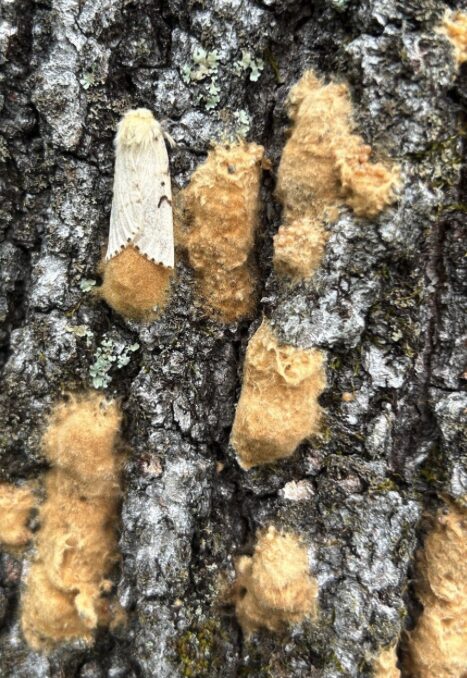One of the threats to our mighty oak trees in Western New York is an invasive pest called the spongy moth — also known as the gypsy moth — that can turn our beloved trees into skeletons. If you believe you’ve been hit, give us a call at 716-273-5522.
Spongy moth (Lymantria dispar dispar) populations in New York State follow a well-documented 10–15-year cycle of booms and busts. While Western New York would be considered low-risk in 2026, vigilance is still needed. In 2023-24, areas in the Hudson Valley were hit hard. Environmentalists are hoping that the state has seen the worst of it for this cycle.
But you never know. In Western New York, reduced natural predators have fueled booms in the past. Amazingly, if unchecked, one female spongy moth can spawn an army capable of stripping 10 acres of forest.
The Devasting Impact: How Spongy Moths Ravage Oaks and Beyond
Oaks – especially red and white varieties common in our region – are spongy moths’ top buffet choice. Why? Their tender, nutrient-rich leaves are like candy to these caterpillars. A single infestation can devour 50-100% of foliage in May and June, leaving trees looking like they’ve been through a leaf-shredding apocalypse.
The harm doesn’t stop at bald branches. Defoliation slashes photosynthesis, starving trees of energy. Stressed oaks become sitting ducks for secondary threats: two-lined chestnut borers drill into weakened wood and Armillaria root rot fungi invade roots. Drought amplifies the pain. Young or mature oaks might bounce back from one bad year, but two or three consecutive hits? Mortality rates climb to 30-50%, per USDA Forest Service data.
It’s not just oaks in the crosshairs. Spongy moths feast on over 300 species, including maples (sugar and red), birches, willows, and even fruit trees like apples in backyard orchards. In mixed forests entire ecosystems suffer — birds lose nesting cover, deer browse harder on understory plants, and soil erosion spikes without leaf litter. Economically? Property values dip with barren yards, and yearly timber losses in New York cost millions during peaks.
The ripple effect hits us all – fewer leaves mean hotter summers and poorer air quality, especially in urban areas.

Spotting the Signs: What to Look For in Your Trees
Early detection is your best defense. Scout your oaks and hardwoods from late winter through summer. Here’s what to hunt for:
— Look for “hairy tennis balls” on your trees or outdoor furniture. These are egg masses that are glued to tree trunks and branches.
— Are caterpillars on the march? In May-June, watch for 1-2 inch, fuzzy crawlers in black, yellow, blue, and white stripes. They “rain” from trees on silk, creating eerie webs. Check trunks at dusk when they’re most active.
— Adult Moths: July-August flights of beige females crawling (they don’t fly) and brown males fluttering signal breeding season.
In Western New York, apps like iNaturalist or DEC’s pest tracker make reporting easy. Snap photos and upload -– citizen science helps map outbreaks.
Prevention Best Practices: Keep Spongy Moths at Bay
An ounce of prevention saves gallons of headache, and cash. Start with vigilance:
— Firewood Quarantine: Never move untreated wood from infested areas. Source local – “buy it where you burn it” is DEC’s mantra. In 2024, this curbed spread from Pennsylvania into Chautauqua County.
— Tree Banding: In areas where infections have been found, wrap trunks with sticky bands or burlap in April to trap climbing caterpillars. Refresh monthly. It’s cheap and chemical-free.
— Boost Natural Enemies: Plant for predators – encourage birds like chickadees with feeders and native shrubs. Parasitic wasps and fungi like “Entomophaga” naturally cull populations during wet springs.
— Yard Cleanup: Rake and destroy fallen leaves in fall to nix overwintering eggs. Mulch around bases to deter soil-dwellers.
Treatment Tactics: From Sprays to Injections
When prevention falls short, act fast –- timing is everything.
Biological controls
There is a biological insecticide you can purchase at Amazon or Home Depot called Bacillus thuringiensis var. kurstaki, known as BTK. It is toxic to caterpillars but safe for humans, pets, birds, earthworms and bees.
BTK is readily available and is marketed under several brand names, often as “BT” or “Bt kurstaki” products. Popular ones include:
• Monterey B.T.: A concentrate or ready-to-spray formula for home gardens.
• DiPel DF: A dry flowable powder, often used in larger-scale or organic farming.
• BT NOW: A water-based liquid concentrate for broad-spectrum caterpillar control.
• Captain Jack’s BT: A ready-to-use spray, bundled with tools for easy application.
• Safer’s BTK: A concentrate targeting common garden pests like cabbage worms.
You don’t need a license to use it, but it’s important to read the directions carefully before applying it. And timing is crucial.
Chemical options
For severe cases, your best bet is to have licenses professionals (like us!) inject the trees with an “EB” product. This is “emamectin benzoate”, a semi-synthetic systemic insecticide derived from avermectin (produced by the soil bacterium Streptomyces avermitilis). It’s highly effective against caterpillar larvae and other chewing insects that damage tree foliage, making it a go-to option for protecting high-value shade trees, ornamentals, and forest hardwoods from defoliation.
EB is not typically available to the public so that’s why you need a state licensed applicator to apply it. There is a new product anticipated to be approved in the Spring of 2026 called Agrilicide that promises to be very effective in targeting the spongy moth. Again, give us a call if you suspect a spongy moth infection.
Post-treatment, fertilize lightly and water deeply to aid recovery. Avoid over-pruning stressed trees.
Wrapping Up: Safeguard Your Oaks, Secure Your Sanctuary
Spongy moths may seem like an unstoppable force, but knowledge is power. By spotting signs early, preventing spread, and treating decisively, you can shield your oaks – and the web of life they support –- from this leafy apocalypse. Western New York’s forests have weathered worse; with your help, they’ll thrive for generations.